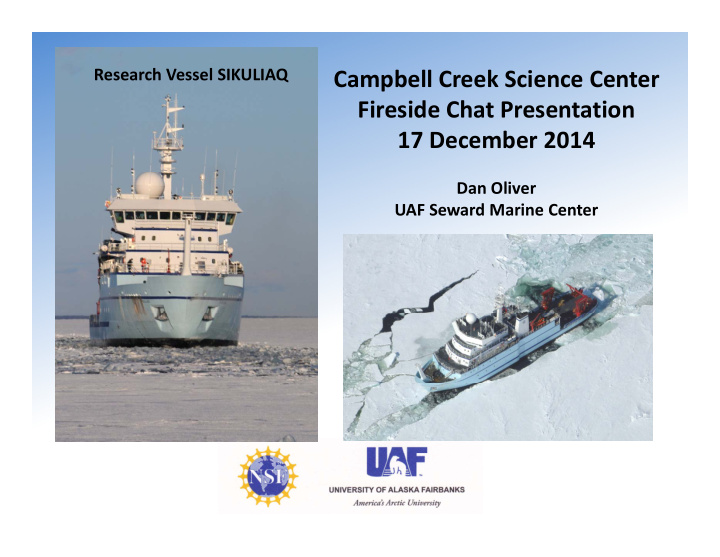



Research Vessel SIKULIAQ Campbell Creek Science Center Fi Fireside Chat Presentation id Ch t P t ti 17 December 2014 Dan Oliver UAF Seward Marine Center
Presentation on the Research Vessel SIKULIAQ • How does SIKULIAQ fit within the University of Alaska System y • What is a SIKULIAQ • The construction process • Post ‐ delivery testing/trials period and funded science
School of Fisheries and O Ocean Sciences S i Seward Marine Center
SFOS Seward Marine Center existing SMC footprint location of the new dolphins p
What is a SIKULIAQ See ‐ KOO ‐ lee ‐ auk • An Inupiat word for “young ice”, “new ice”, or “thin ice” • This is ice described as new ice without snow that is safe to walk on.
What is R/V SIKULIAQ? • Alaska Region Research Vessel (ARRV) • Ice ‐ capable general oceanographic research ship • 261 feet 6 inches length • 4065 LT at design draft • 5,750 HP , • 20 crew, 2 marine techs, 24 scientists • Integrated power plant with AC propulsion motors • Tractor style Z drives • Tractor style Z ‐ drives • Funded and owned by NSF, was built and operated by UAF • UNOLS Global Class fleet – Arctic Region Research Vessel
SCIENCE CAPABILITIES SCIENCE CAPABILITIES SIKULIAQ will provide the tools needed to support ocean research on the SIKULIAQ will provide the tools needed to support ocean research on the emerging critical questions with world wide capability, but a focus on the emerging critical questions with world wide capability, but a focus on the North Pacific, Bering Sea, and Arctic Ocean North Pacific, Bering Sea, and Arctic Ocean North Pacific Bering Sea and Arctic Ocean North Pacific Bering Sea and Arctic Ocean State ‐ of ‐ the ‐ art acoustic systems for bathymetry and bottom mapping • “Hands ‐ free” over ‐ the ‐ side profiling and water sampling system p g p g y • Capability for deck arrangements to be configured for piston cores, mooring deployments, • ROV deployments, biological tows etc. Acoustically quiet ice capable vessel • Deck services for ROV and AUV deployments and support vans Deck services for ROV and AUV deployments and support vans • • Accommodations for large multidisciplinary science parties • Environmental chamber and freezer for controlled experiments • Excellent sea keeping and station keeping capabilities • Can accommodate up to four science vans • State ‐ of ‐ the ‐ art science data and communications systems •
Instrumented foremast Instrumented foremast Excellent visibility Small boats 120,000 lb A ‐ frame , T Two large 30 ‐ ton cranes l 30 t Side launch science packages Extensive SONAR suite and centerboard E i SONAR i d b d Z ‐ drives and ice reamers
SIKULIAQ Project Status SIKULIAQ Project Status • Project award to UAF in summer 2007 • Shipyard contract awarded December 2009 Shi d t t d d D b 2009 • Launched in October 2012 • Delivered 6 June 2014 • Post ‐ delivery science testing and transit July 2014 through June 2015 • Two funded science cruises in late 2014 Two funded science cruises in late 2014 • Ice trials in the Bering Sea spring 2015 • Five funded Arctic science cruises in Summer 2015 • 2016 f nded science sched le nder de elopment b t high • 2016 funded science schedule under development, but high level of interest
Rollout For Launch
SIKULIAQ enters the water for the first time ‐ successfully
495,000 gallons fuel consumed 280,000 gallons from now to Seward • Sailed from Marinette on 6 July • First science mission 17 Nov to 12 Dec • Cleveland, OH 14 July Honolulu to Honolulu • Montreal, Quebec 23 July • Second science mission 16 Dec to 15 Jan • Woods Hole MA 31 July Woods Hole, MA 31 July Honolulu to Guam H l l t G • San Juan, PR 11 September • Ketchikan, AK 9 February • Panama Canal 27 September • Juneau, AK 16 February • Honolulu, HI 11 October • Seward on 24 February
Q Questions? ti ?
Recommend
More recommend